Fiddle leaf fig - do I really have to air layer to propagate?
I have a very leggy, very healthy fiddle leaf that has hit the ceiling of my sun room. I realize I have to cut it in order to make it bushier, and would like to propagate what I cut off. Air layering seems really complicated and time consuming. Is it possible to just stick them in water,the way I do with all my other plants, or will it definately not work?
Comments (16)
jhunter194
8 years agoSorry to dig this thread up, but it seemed the most appropriate thread for advice. I was planning on pruning my FLF this summer to try to get it to branch out a bit more. Will air layering accomplish the same task as pruning? If I'm looking to prune around June (zone 7a), when should I begin air layering? Any FLF specific tips on air layering?
Related Professionals
Surprise Landscape Architects & Landscape Designers · Havre de Grace Landscape Architects & Landscape Designers · Hilton Head Island Landscape Contractors · Lynn Landscape Contractors · Newberg Landscape Contractors · North Ridgeville Landscape Contractors · Pleasant Hill Landscape Contractors · San Antonio Landscape Contractors · Bonney Lake Decks, Patios & Outdoor Enclosures · Portland Decks, Patios & Outdoor Enclosures · Santa Monica Decks, Patios & Outdoor Enclosures · Brooklyn Fence Contractors · Golden Fence Contractors · Woodinville Fence Contractors · Saratoga Springs Fence Contractorstapla (mid-Michigan, USDA z5b-6a)
8 years agoWill air layering accomplish the same task as pruning? There is no clear answer because of the number of variables, and of course "pruning" is a broad term and might represent an operation that is confined to a single branch, to branch tips of a branch or 2 or 3 ....., or could involve every branch on the plant. Also, the method of layering determines in large part how close the comparison is between layering a branch and severing it. E.g., if you use the ring cut method, the hormonal impact on the rest of the plant is essentially the same as if the branch was severed, but if the flap method is used, or a tourniquet is applied, it's not the same as pruning because auxin flow is only partially restricted. Basically, all the qualifications I'd need to supply so I could be comfortable my answer could be taken at face value would be exhaustive.
Pinching is the best way to create a full canopy. If the tree is healthy, pinch all branches back to 2 leaves and wait for 2 new branches to occur in the axils (crotches) of those leaves. Allow those 2 branches to extend to 4 leaves, then pinch back to 2 again. You'll get 4 branches from the 2, then 8 from the 4, 16 from the 8, 32 from the 16, ......
If I'm looking to prune around June (zone 7a), when should I begin air layering? If you're going to prune in June (unless you reconsider - based on what I said), start the layer now and use the ring method. If you'd applied a tourniquet months ago and had started to blanch the bark (blanch = exclude light) in the area where you want roots, it would have sped things up considerably. If your tree is healthy or you can get it outdoors in late May, you might have roots enough to separate the layer by the solstice.
I like to layer using a pot and soil, rather than moss and wrapping with plastic.
It saves a step.
The entire top of this plant (on the right in the pic) is being layered off of its old root system because reworking the roots so the tree can become a quality bonsai when it grows up would be much harder than growing an entirely new root system.

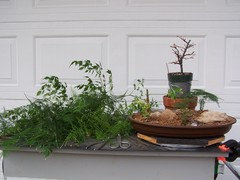
Just in case anyone was wondering what the heck I was doing with that pile of brush next to the planting:
Alspjin
7 years ago@jhunter194
Did you end up air layering? I tried it for the first time with my FLF and it turned out beautifully. I put up a post about it with pictures. Just curious about how it went for you. It's kind of funny that I've put this much effort into it because I'm not sure where I'm going to fit another one of these in the house.
Ash
6 years agolast modified: 6 years agoI was wondering if I could get some clarification on what Al said :
"prune all but the top 1 or 2 leaves off (leave the tip for a standard, or a tree with 1 trunk)"
are the "top" leaves referring to those that are most distal from the main trunk? Not sure what you mean by top leaves on the branch
And Does this mean I should not air layer and then pinch the top of my main trunk on my FLF? I want to encourage more branching off the main trunk so I was hoping to make the cut at the red line here. But it sounds like I shouldn't do this? If I'm understanding correctly... should I notch along the main trunk instead to encourage more branches off the trunk?

tapla (mid-Michigan, USDA z5b-6a)
6 years agoWhen you make a cutting, if you leave the apex (tip - growing end of a stem or branch) on the cutting, it will continue to extend. If you remove the tip, it can't extend, and you'll get a multi-stemmed plant. You CAN remove all of the stems but one if you like, to produce a single stemmed plant, but it's easier to grow a standard from a a tip cutting as opposed to an internodal cutting.
If you start your layer at the line and don't remove the apex/tip-prune the layer, the layer will continue to extend. If you DO tip-prune the layer, you'll likely get a stem/trunk from the axil (crotch) of each leaf you leave and in many cases from dormant buds immediately above old (leaf) bundle scars where a leaf used to be attached.
Once you start a properly executed air layer, you will have blocked the polar flow of the growth regulator that suppresses back-budding (auxin). So, even though the apex might still be on the layer, the tree below the layer will respond as though you removed it because auxin moves downward in the phloem and you will have removed the phloem when you created the layer.
AlAsh
6 years agoThanks for your response Al, lots of good information! I think I'll leave the tip of my main trunk intact as I'd like a bit more height to my current tree.
ewan ng
6 years agoHi Al, I just followed your pinching advise to groom my fiddle leaf fig. I planted the cut branch in 100% perlite. It doesn't hold much water so I'm wondering how often shod I water the cutting? Also, when should I move it to a 5-1-1 mix?
tapla (mid-Michigan, USDA z5b-6a)
6 years agoPerlite holds much more water than you think - more than 2.5X it's own weight. Move to 5:1:1 when you see evidence of the second generation of leaves.
AlLisa H
2 years agoI took the leap and chopped off the top and have been attempting to root it in perlite…
It’s not going well..
Why is the stem starting to look like a shriveled up prune??
Guys is my plant dying?tapla (mid-Michigan, USDA z5b-6a)
2 years agoThe 2 primary reasons the propagule isn't cooperating are 1) there was far too much leaf surface left on the propagule. Without a mist set-up or tenting the propagule, the rootless propagule cannot be expected to be able to absorb and replace transpirational water loss, which is directly related to the collective surface area of all leaves. I probably would have severed the petiole (leaf stem) of all but the top leaf, leaving only a single leaf at the apex; then, I would have removed 1/2-2/3 of the leaf at the apex by cutting straight across venation (veins).
Propagule (Mexican petunia) before trimming in preparation for sticking (planting):
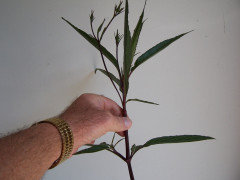
Propagule ready for sticking: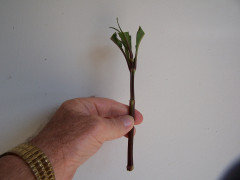
2) I'm assuming there is no drain hole in the bottom of that jar. I can't tell where the water line is in the perlite (how full of water the jar is), but the proximal/ bottom end of the cutting should be well above the water line in order that the cutting has access to an ample amount of oxygen, which is an important part of how long a cutting takes to strike.
Attempting to root a cutting, is something like a race. The grower should strive to prepare the cutting appropriately and ensure cultural conditions are conducive to rapid root formation and a functional vascular connection to the rest of the propagule. The 'race' part is in the idea roots must form speedily enough that fungal pathogens haven't enough time to 'clog the plumbing' and make a root to vasculature connection impossible.
Al
Cassie (8b Southern AZ, high desert)
last yearlast modified: last year@tapla (mid-Michigan, USDA z5b-6a)
Hi Al, do you normally use the ring or the tourniquet method when you air layer your focus ficus plants? Or do you do a combination of both (you mentioned using a tourniquet and blanching part of the stem/branch?)?
What type of soil do you use when you air layer, since you don't use sphagnum moss? I'm assuming this is one of the few times you want something moisture retentive - do you use a regular potting soil? Peat moss? Seed starting mix?
And last question (for now!), what time of year do you typically start your air layering? Do you try to time it to plant the new plant in June, or is some other time preferable? I'm wondering if it's better to start the process in June, since you're effectively pruning the parent plant, which would put separating the new plant sometime in August?
Thanks in advance! (And I suppose apologies for resurrecting an old thread, but made more sense in my mind than starting a fresh one and linking back here)
tapla (mid-Michigan, USDA z5b-6a)
last year@Cassie (8b Southern AZ, high desert)
Hi Al, do you normally use the ring or the tourniquet method when you air layer your ficus plants? Or do you do a combination of both (you mentioned using a tourniquet and blanching part of the stem/branch?)? It would depend on the Ficus species. For most Ficus, I propagate by cuttings, because I've found that under mist or in a humidity chamber, you can start some really thick cuttings of many ficus species (3"+). This image of F salicifolia was a cutting started from the top of a much larger tree.


Same tree as above - first pruning after rooting ^^^.

Ficus microcarpa cutting ^^^ in process of rooting - note new buds opening. Removing the tops of trees in training is sort of a way to create an almost instant bonsai. Once the tree is fully rooted. a little wiring to reposition branches will turn it into a 'believable' tree, resembling something one might see in nature.
If we take the misting and high humidity out of the equation, I prefer ringing the plant; however, even when I use the ring method, I often use a tourniquet immediately below the top of the ring. While I'm thinking of it, the rule of thumb for the ht of the ring is, it should be at least 1/5x the diameter of the branch/ trunk being layered. Also, when you peal the bark back on many species of trees, a very thin layer of vascular cambium usually remains attached to the sapwood beneath it. It is crucial to remove that white/tan layer of tissue as part of the layering process.
I'm guessing my reason for layering is probably going to differ from yours. Most plants I layer is because they are seedlings, and as such have a very ugly root system. Strong roots that radiate horizontally away from the trunk and a trunk flare at the base of the tree eventually become a critical consideration for almost every bonsai enthusiast who has practiced bonsai for more than a decade. Eventually, we develop the idea that everything we do should focus on bringing out the tree's best potential, even if we are not the owner who sees it realized. Often, that will result in trees in training for 20 years before they even see a bonsai pot. I couldn't even guess at the number of times I've been a part of brain-storming over a tree, my own or someone else's, and making radical changes that turn a tree which is an acceptable specimen in its own right, back into a bonsai in training for the sole reason a better way to bring out the tree's potential was discovered.
The image below is a Trident maple which was air-layered off of it's original set of roots which were way to ugly for my purposes. I used only the ring method for this tree (wire still attached if you look closely). Notice how the roots are almost perfectly spaced (some incongruity adds to the appeal of living plants) and radiating away from the trunk. That is what I was after.

The tree below is a Korean hornbeam, and 3-image sequence below shows first what a tree's seedling roots usually look like. Many growers work hard at trying to get these roots straightened around, but I have learned better results cam be had in far less time and with less effort, bu layering the plant off of its old roots.
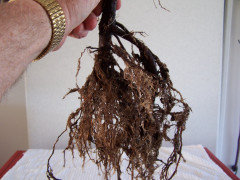
This is one way of using the tourniquet method (below), which takes much longer than ringing/ girdling or a combination of a tourniquet and ringing/ girdling. With a tourniquet, as the diameter of the trunk increases the vascular cambium is compressed as the tourniquet tightens. This 'chokes off' downward movement of photosynthate (the plant's food) and auxin, the hormone that stimulates root development and branching. With food and a surplus of the tree's natural rooting hormone accumulating immediately above the tourniquet, you can be quite certain of a plethora of roots emerging within a short vertical space.
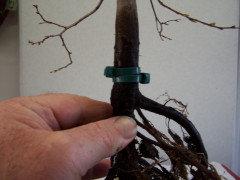
With an understanding of the tree's wounding response, I deduced that drilling holes with a 3/16 brad-point drill turned with my fingers and filled with a insoluble rooting gel should help coax the tree into producing an exceptional root base. The roots in the first image (of the trident maple) are the result of this method.
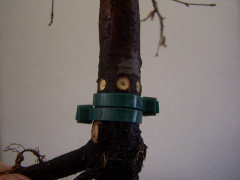
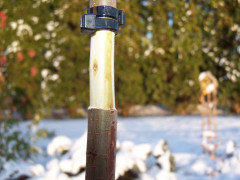
Ring + tourniquet method ^^^
BTW - I no longer use zip ties as a tourniquet as they sometimes fail/ break - especially on thick layers on branches/ trunks larger than 1". I use 2-3 wraps of aluminum bonsai wire in size 2-3mm with the ends twisted tight with pliers. The wraps should touch each other, which forces all rooting to occur above the layer.
What type of soil do you use when you air layer, since you don't use sphagnum moss? I'm assuming this is one of the few times you want something moisture retentive - do you use a regular potting soil? Peat moss? Seed starting mix? I usually use gritty mix for just about everything I use a pot to layer.
Below, there are 2 things going on. I had just finished establishing an air layer on the hornbeam in the background and I was working on pruning 2 China dolls and 2 asparagus ferns. I was layering the hornbeam because the trunk was much too long/ tall given the thickness of the trunk, so the best way to shorten the trunk was to layer it off of it's old roots and start a new root system higher up. The top of the ring cut is at approximately the ht of the duct tape holding the pot together.

Below, is a hackberry tree being layered. You can see the gritty mix in the pot


This is the same hackberry, same summer, after being separated from the mother plant. In case you noticed, it's planted deep on purpose. I will let it grow wild (almost completely unpruned) and begin work on it in spring of '24.
And last question (for now!), what time of year do you typically start your air layering? Spring. I like to have them separated by the end of July.
Do you try to time it to plant the new plant in June, or is some other time preferable? If we're still talking about Ficus, spring will always be the best time. If I was layering, I would start the layer on Ficus just before or when I move them outdoors. They really start to want to grow then, so we might as well take advantage of the tree's natural inclinations.
I'm wondering if it's better to start the process in June, since you're effectively pruning the parent plant, which would put separating the new plant sometime in August? Geography plays an important role in deciding what the best timing is. I bet you would be fine starting your layers in early May, especially if your plants are outdoors. Then, you should have no problem separating in July-August.
Thanks in advance! (And I suppose apologies for resurrecting an old thread, but made more sense in my mind than starting a fresh one and linking back here). No worries. Things are slow on the forum and my wife is recovering from some recent surgery, so I have to be home and indoors for a few more days, it looks like. I'm glad for the opportunity to kill some of the time it always seems so important to save. ;-)
Al
Cassie (8b Southern AZ, high desert)
last yearlast modified: last year@tapla (mid-Michigan, USDA z5b-6a)
So looking at your photos with the pot/gritty mix, you leave it open (unlike the sphagnum moss technique where it's "sealed" in plastic) and just water like you regularly do with the parent plant?
I might need to modify the mix to have more turface for water retention (everything dries out so fast here!) but it would certainly be nice to have good roots from the start rather than dealing with the sphagnum moss mess...
Of course, I'm moving to another state in June so could be rough trying all of this during the upcoming summer 😅 but maybe I can take this spring/summer to experiment on a couple of my "extra" ficus elastica and then move on to my fiddle leaf next summer (they'll be due for repotting that spspring I think)
tapla (mid-Michigan, USDA z5b-6a)
last yearSo looking at your photos with the pot/gritty mix, you leave it open (unlike the sphagnum moss technique where it's "sealed" in plastic) and just water like you regularly do with the parent plant? I had planned on addressing this issue soon after I began the my post immediately above, but was called away for a time before I could finish it all in a continuous line of thought, which is to say I forgot. I use the method you described, too.

This is Fockea edulis (a caudiciform succulent) being air-layered. The plastic bag is filled with damp sphagnum moss (not to be confused with sphagnum peat).
Sphagnum moss:

The layer is in place in the image above. The next step is to cover it with aluminum foil. There are several reasons for that. 1) Some roots don't tolerate light well. 2) lots of light often causes algae growth in the layer's closed environment, which competes with new roots for available oxygen. 3) Clear wrap traps heat generated within the confines of the plastic wrap (passive solar gain) and can help to drive root temperatures well above killing highs ..... around 120*F for most plants.
For smaller projects on branches/ trunks up to about .5" I usually use these handy-dandy layering containers, which are reusable. There is less internal heat build-up when using the black opaque devices compared to clear; still, I wrap them in foil while the layer is progressing.
Some plants, like temperate conifers, are slow to root, so the layer must remain in place through one grow season into the next. Whenever this is necessary (carry over the layer from one year to the next), no matter what the plant, it is essential to protect the layer from freezing temperatures.
I might need to modify the mix to have more turface for water retention (everything dries out so fast here!) but it would certainly be nice to have good roots from the start rather than dealing with the sphagnum moss mess... You can cover the top of the soil with plastic or aluminum fool to slow water loss from evaporation. I do the watering rounds daily, even if not all plants get water, so there is no saved effort if I try to limit water loss. For plants rooted in the ground, I'd be more apt to use a closed system that needs looking at (as far as moisture levels are concerned) no more than every week or two. Sometimes, I will layer a wild plant I find far from home or in the landscape somewhere (with permission). For those I always use a closed system. I've never been refused a request to layer a plant and have invariably found it's owner or caretaker to be somewhere between very interested and amazed at the entire idea, from the fact it can be done to what the plant will be used for. I always take a couple of small bonsai specimens with me and a small give-away plant that has had some minor training.
Of course, I'm moving to another state in June so could be rough trying all of this during the upcoming summer 😅 but maybe I can take this spring/summer to experiment on a couple of my "extra" ficus elastica and then move on to my fiddle leaf next summer (they'll be due for repotting that spspring I think)
Just a thought ..... you had mentioned blanching. It's very effective on about any plant and speeds the process quite a bit. BTW - If you are going to move your trees when you change locations, there is no reason you can't move a tree with a layer in progress ..... unless it's rooted in the ground, of course.
Al
















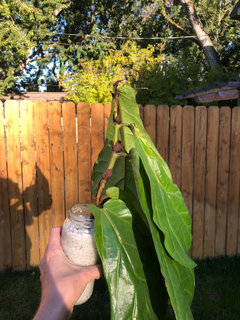

tapla (mid-Michigan, USDA z5b-6a)